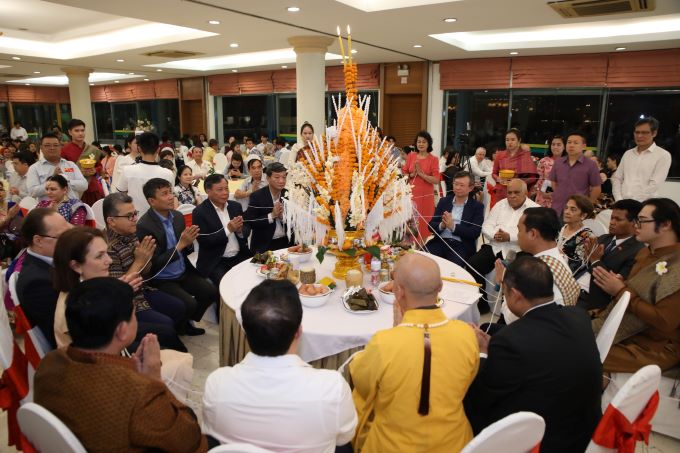Bulletins Friendship and cooperration

The traditional New Year festival of Laos, also known as Bun Pi May, usually takes place from April 13th to15th each year when the skies are clear and the rivers are full of water.
Lao New Year Festival (Bun Pi May)
The traditional New Year festival of Laos, also known as Bun Pi May, usually takes place from April 13th to15th each year when the skies are clear and the rivers are full of water. This is a sacred and important moment for the people of the Land of a Million Elephants. The Bun Pi May festival signifies bringing coolness, prosperity to all things, warmth, happiness, and purification of human life.

Laotians focus on cleanliness on the first day of the new year. They often clean their houses thoroughly, prepare fragrant water, and flowers. The fragrant water is a mixture of water, turmeric, roasted sesame, flowers, and fragrant oil. The water is infused with the scent of flowers or natural fragrances. Later on, people also add cream and powder. In the afternoon, people go to the temples to perform Buddha worship, pray, and listen to the teachings of monks. Afterward, they bring the Buddha statues to a special room for 3 days and open the door for everyone to come and bathe the Buddha. The fragrant water that is used to pour over the Buddha statues is collected and brought home for people to apply on themselves for blessings. Water is also poured on monks, temples, and trees around the temple. Laotians believe that water helps wash away bad things, illnesses, and wish for a long and healthy new year.
Laotians pay great attention to preparing traditional dishes, especially “lap”. In the local language, “lap” means “prosperity”. Lap is usually made from fresh chicken or beef mixed with spices. According to many Lao cultural experts, “lap” is seen as the soul of Laotians in the new year. People often gift each other “lap”. The family that receives more of this dish is believed to have a prosperous new year.
Cambodian New Year (Chol Chnam Thmay)
Cambodian New Year, also known as Chol Chnam Thmay, is usually celebrated around mid-April, lasting for 3 days, and extending to 4 days in leap years with each day having a different name for the festival. The first day is called Moha Songkran (Chôl sangkran Chmây), the second day is Wanabat (Wonbơf), and the third day is Tngai Laeung Saka (Lơm săk).
On the first day of the new year, people dress nicely, bring offerings to the temple to worship the Great Calendar. The second day involves offering rice and making sand mountains. Each family offers rice to the monks at the temple in the morning and noon. In the afternoon, they create sand mountains to seek blessings. People build sand mounds in eight directions and one central mountain, symbolizing the universe. This ritual, according to ancient tradition, expresses the desire for rain and blessings for humanity. The third day involves bathing Buddha statues as a gesture of gratitude to the Buddha and cleansing away any misfortunes from the old year, stepping into the new year with everything going well.
After the temple ceremony, people escort monks to the cemetery to perform rituals to pray for the souls of the deceased. Afterwards, everyone returns home to bathe Buddha statues at their homes, offer prayers and blessings to their ancestors, asking for forgiveness for any shortcomings of the previous year.
Thai New Year (Songkran)
In Thailand, where Buddhism is the national religion, the traditional New Year festival is highly significant for the people. Thais call their New Year celebration Songkran. Since 1941, the Thai royal family has stipulated that Songkran New Year begins on April 13th each year. This is a time for Thais to express reverence to the Buddha. The first ritual of great importance on the first day of the new year is the Buddha bathing ceremony at the temple. People go to the temple to participate in the Buddha bathing ceremony, bring fruits, and vegetarian dishes to offer to the monks, then release birds as a form of merit-making. Afterwards, they return home to splash fragrant water, wishing for blessings.

Thais dedicate two days specifically for preparation. During these two days, according to tradition, people go to the riverside and build sand pagodas, with the belief that each grain of sand will carry away a worry.
Thais often wear elaborate costumes during the festival. Each local festival has its own unique characteristics. Bangkok, the capital, hosts many festivals and cultural activities during the New Year. People pour into the streets and splash water on each other using buckets, water guns... with the belief that the more water they receive, the luckier they will be.
Every year, the Hanoi Union of Friendship Organizations, in collaboration with some Embassies in Vietnam, organizes a program called "Celebrating the New Year of Some Asian Countries". This program reenacts the traditional New Year ceremonies of each country, allowing participants to experience the atmosphere of New Year in their homeland. Through this, it enhances mutual understanding, cultural exchange, and strengthens the solidarity between the Vietnamese people, the people of Hanoi and the people of countries around the world.
Nguyen Hien